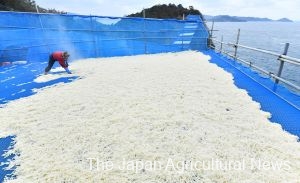Yudeboshi-Daikon (boiled and dried radish) gets more flavor in cold wind (Saikai City, Nagasaki Prefecture)
NAGASAKI, Feb. 6 – Omotate Region, Saikai City, Nagasaki Prefecture, is now busy making yudeboshi-daikon (dried radish stripes), an amazing traditional food. Local farmers are drying boiled daikon radish strips on the structure built on the coastline facing the Goto-nada Sea, utilizing northwestern sea wind, which is necessary to deepen the flavor of the product. Steam rises from the boiled radishes, and that is one of the most typical sights on a cold winter’s day here.
Yudeboshi daikon is a non-perishable food. The farmers cut daikon radishes into stripes, boil and dry them in the cold air for one whole day and night. They use Daiei Okura daikon, which is 50% bigger than Aokubi daikon, the most common variety in Japan. It is a high-yield variety that doesn’t go mushy in texture when boiled nor darker in color when dried.
Mamoru Hashiguchi grows the radishes in his 3-hectare field. The 49-year-old farmer started harvesting in December, and his family of five will keep producing yudeboshi-daikon until February. They peel the radishes, machine-cut them into pieces of 5 to 6 millimeters in thickness and 1 centimeter in width, and boil the strips for 10 to 15 minutes. Then, they put the very hot strips on the structure.
“Almost all the processes are manual, but that will make them taste better,” he said while stirring boiling water.
Local farmers used to make yudeboshi-daikon privately for their own families, but a local agricultural cooperative encouraged them to commercialize. About 40 years ago, the cooperative set up a producers’ group to increase the shipment to the Kansai (west Japan) region. A total of 11 member farmers of the JA Nagasaki Seihi Yudeboshi Daikon Producers Group grow the big-size daikon at their fields of 18 hectares.
The farmers cut mountainsides to build the drying structure about 30 years ago. Exposure to the strong sea breeze from the northwest is the key to produce the beautiful amber color products.
“We want to preserve this traditional method that brings out the beautiful flavor,” said Chizuko Hashiguchi, the 74-year-old mother of Mamoru.
Source: http://english.agrinews.co.jp/?p=10403

